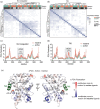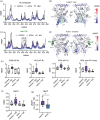The nuclear receptor LRH-1 discriminates between ligands using distinct allosteric signaling circuits
- PMID: 37572334
- PMCID: PMC10510465
- DOI: 10.1002/pro.4754
The nuclear receptor LRH-1 discriminates between ligands using distinct allosteric signaling circuits
Abstract
Nuclear receptors (NRs) are transcription factors that regulate essential biological processes in response to cognate ligands. An important part of NR function involves ligand-induced conformational changes that recruit coregulator proteins to the activation function surface (AFS), ~15 Å away from the ligand-binding pocket. Ligands must communicate with the AFS to recruit appropriate coregulators and elicit different transcriptional outcomes, but this communication is poorly understood. These studies illuminate allosteric communication networks underlying activation of liver receptor homolog-1 (LRH-1), a NR that regulates development, metabolism, cancer progression, and intestinal inflammation. Using >100 μs of all-atom molecular dynamics simulations involving 74 LRH-1 complexes, we identify distinct signaling circuits used by active and inactive ligands for AFS communication. Inactive ligands communicate via strong, coordinated motions along paths through the receptor to the AFS. Activating ligands disrupt the "inactive" circuit and induce connectivity with a second allosteric site. Ligand-contacting residues in helix 7 help mediate the switch between circuits, suggesting new avenues for developing LRH-1-targeted therapeutics. We also elucidate aspects of coregulator signaling, showing that localized, destabilizing fluctuations are induced by inappropriate ligand-coregulator pairings. These studies have uncovered novel features of LRH-1 allostery, and the quantitative approach used to analyze many simulations provides a framework to study allosteric signaling in other receptors.
Keywords: LRH-1; allosteric regulation; ligand regulation; molecular dynamics; nuclear receptor; structure-function.
© 2023 The Authors. Protein Science published by Wiley Periodicals LLC on behalf of The Protein Society.
Figures








Update of
-
The nuclear receptor LRH-1 discriminates between ligands using distinct allosteric signaling circuits.bioRxiv [Preprint]. 2023 Jan 28:2023.01.27.525934. doi: 10.1101/2023.01.27.525934. bioRxiv. 2023. Update in: Protein Sci. 2023 Oct;32(10):e4754. doi: 10.1002/pro.4754. PMID: 36747705 Free PMC article. Updated. Preprint.
Similar articles
-
The nuclear receptor LRH-1 discriminates between ligands using distinct allosteric signaling circuits.bioRxiv [Preprint]. 2023 Jan 28:2023.01.27.525934. doi: 10.1101/2023.01.27.525934. bioRxiv. 2023. Update in: Protein Sci. 2023 Oct;32(10):e4754. doi: 10.1002/pro.4754. PMID: 36747705 Free PMC article. Updated. Preprint.
-
Unexpected Allosteric Network Contributes to LRH-1 Co-regulator Selectivity.J Biol Chem. 2016 Jan 15;291(3):1411-26. doi: 10.1074/jbc.M115.662874. Epub 2015 Nov 9. J Biol Chem. 2016. PMID: 26553876 Free PMC article.
-
A phospholipid mimetic targeting LRH-1 ameliorates colitis.Cell Chem Biol. 2022 Jul 21;29(7):1174-1186.e7. doi: 10.1016/j.chembiol.2022.03.001. Epub 2022 Mar 21. Cell Chem Biol. 2022. PMID: 35316658 Free PMC article.
-
Allosteric mechanisms of nuclear receptors: insights from computational simulations.Mol Cell Endocrinol. 2014 Aug 5;393(1-2):75-82. doi: 10.1016/j.mce.2014.05.017. Epub 2014 Jun 6. Mol Cell Endocrinol. 2014. PMID: 24911885 Review.
-
Molecular basis for the regulation of the nuclear receptor LRH-1.Curr Opin Cell Biol. 2015 Apr;33:26-34. doi: 10.1016/j.ceb.2014.10.007. Epub 2014 Nov 15. Curr Opin Cell Biol. 2015. PMID: 25463843 Review.
Cited by
-
Nuclear receptors in health and disease: signaling pathways, biological functions and pharmaceutical interventions.Signal Transduct Target Ther. 2025 Jul 28;10(1):228. doi: 10.1038/s41392-025-02270-3. Signal Transduct Target Ther. 2025. PMID: 40717128 Free PMC article. Review.
-
Liver receptor homolog-1: structures, related diseases, and drug discovery.Acta Pharmacol Sin. 2024 Aug;45(8):1571-1581. doi: 10.1038/s41401-024-01276-x. Epub 2024 Apr 17. Acta Pharmacol Sin. 2024. PMID: 38632319 Free PMC article. Review.
-
A novel heuristic of rigid docking scores positively correlates with full-length nuclear receptor LRH-1 regulation.Comput Struct Biotechnol J. 2024 Jul 30;23:3065-3080. doi: 10.1016/j.csbj.2024.07.021. eCollection 2024 Dec. Comput Struct Biotechnol J. 2024. PMID: 39185441 Free PMC article.
-
Simulations Reveal Unique Roles for the FXR Hinge in the FXR-RXR Nuclear Receptor Heterodimer.ACS Bio Med Chem Au. 2024 Nov 27;5(1):194-203. doi: 10.1021/acsbiomedchemau.4c00105. eCollection 2025 Feb 19. ACS Bio Med Chem Au. 2024. PMID: 39990948 Free PMC article.
-
Enhanced dynamic coupling in a nuclear receptor underlies ligand activity.J Biol Chem. 2025 Feb;301(2):108081. doi: 10.1016/j.jbc.2024.108081. Epub 2024 Dec 14. J Biol Chem. 2025. PMID: 39675705 Free PMC article.
References
-
- Bolado‐Carrancio A, Riancho JA, Sainz J, Rodriguez‐Rey JC. Activation of nuclear receptor NR5A2 increases Glut4 expression and glucose metabolism in muscle cells. Biochem Biophys Res Commun. 2014;446(2):614–619. - PubMed
-
- Case D, Ben‐Shalom IY, Brozell SR, Cerutti DS, Cheatham TE III, Cruzeiro VWD, et al. Amber 2018. San Franscisco: University of California; 2018.
Publication types
MeSH terms
Substances
Grants and funding
LinkOut - more resources
Full Text Sources

